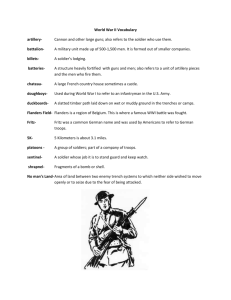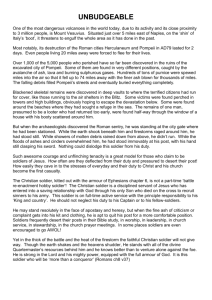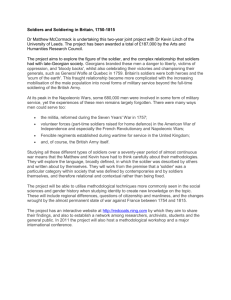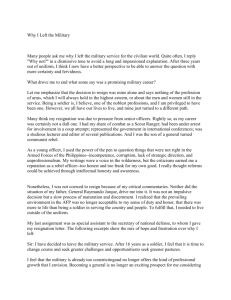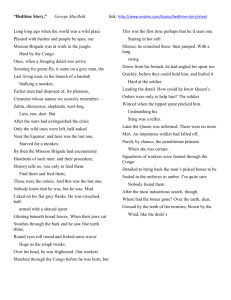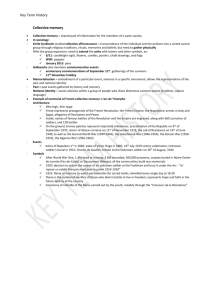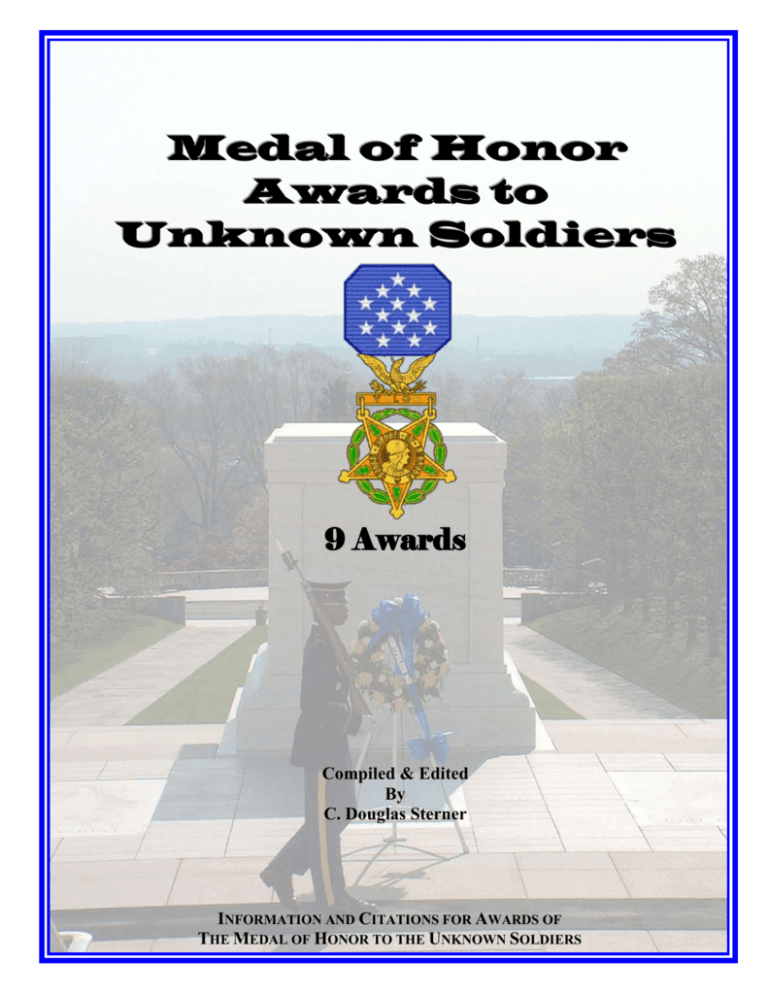
Medal of Honor
Awards to
Unknown Soldiers
9 Awards
Compiled & Edited
By
C. Douglas Sterner
INFORMATION AND CITATIONS FOR AWARDS OF
THE MEDAL OF HONOR TO THE UNKNOWN SOLDIERS
MEDAL OF HONOR AWARDS
TO THE
UNKNOWN SOLDIERS
Compiled & Edited
By
C. Douglas Sterner
Copyright © 2006 by HomeOfHeroes.com
ALL RIGHTS RESERVED
Made Available By
HomeOfHeroes.com
P.O. Box 122
Pueblo, CO 81005
The American Unknown Soldiers
The Tomb of the Unknown Soldier is the most visited gave site at Arlington National Cemetery,
or for that matter, in America. Beneath the white marble sarcophagus lies the body of an unidentified
American soldier from World War I. West of the sarcophagus beneath three marble slabs that lie flush
with the plaza are crypts for the unidentified remains of an American soldier from World War II and
Korea, and the empty crypt that once held the unidentified remains of a serviceman from Vietnam.
The remains of the Vietnam Unknown Soldier were
exhumed May 14, 1998. Based on mitochondrial
DNA testing, Department of Defense scientists
identified the remains as those of Air Force 1st Lt.
Michael Joseph Blassie, who was shot down near
An Loc, Vietnam, in 1972. Lieutenant Blassie was
subsequently reinterred near his family's home in St.
Louis, Missouri. Based upon the advancements in
remains identification it seems unlikely that body of
a truly unknown soldier from the Vietnam war could
ever be found, and it has been determined that the
crypt will therefore remain empty.
Page 1
The selection process of the Unknown Soldiers and the ceremony with which each was interred
has been both intricate and moving. Near the Tomb of the Unknown Soldier is a large plaque that
details that history.
Under authority of Public Resolution 67, of the 66th Congress, approved March 4, 1921, An unknown
American Soldier was exhumed from each of the four American cemeteries in France. They were placed in
identical caskets and assembled at Chalons Sur Marne.
The Unknown Soldier was selected on October 24, 1921. Sergeant Edward F. Younger, US Army, carrying
a spray of white roses, entered the room where the four unmarked, flag draped caskets were resting. He slowly
circled, silently placing the roses on one of the caskets. Thus the unknown soldier was officially designated. The
three remaining unknowns were then returned to the Meuse Argonne Cemetery.
The unknown soldier was placed aboard the US Cruiser Olympia, which arrived at the Nation's Capitol on
November 9, 1921. The honored remains were taken to the Rotunda of the United States Capitol to rest in state
until Armistice Day on November 11. The Unknown Soldier was moved to the Memorial Amphitheater in Arlington
National Cemetery. After services in the Amphitheater, the remains were borne to the sarcophagus for brief
committal rites. The impressive ceremony closed with three salvos of artillery, the sounding of Taps, and the
National Salute.
Under authority of Public Law 429, 79th Congress, Approved 24 June 1946. 13 Unknown Americans who
lost their lives while serving overseas in the Armed Forces of the United States during World War II were
exhumed from American cemeteries in Europe and Africa and shipped in identical caskets to Epinal, France.
Major General Edward J. O'Neill, US Army, on May 12, 1958, solemnly chose from among these caskets one to
be designated as the Trans Atlantic candidate Unknown. The remaining unknown Americans were reinterred.
The remains of two unknown Americans were disinterred on April 15, 1958 from the National Cemetery of
the Pacific, Hawaii, and four unknowns were disinterred from the Fort McKinley American Cemetery and Memorial
in the Philippines. The six unknowns wee then taken to Hickam Air Force Base, where on May 16, 1958, Colonel
Glenn T. Eagleston, US Air Force, placed a white carnation lei, selecting the candidate Unknown to represent the
Trans Pacific Phase of World War II. The five other caskets were reinterred.
Page 2
The candidate unknown was then transported to the cruiser Canberra where the final selection of the World
War II unknown took place on the after-missile deck of the Canberra. Hospitalman First Class William R.
Charette, the Navy's only active enlisted holder of the Medal of Honor, had the distinction of making the selection
of the World War II unknown. After a moments hesitation he placed a wreath at the foot of the casket on his right.
This was the Unknown of World War II. The unknown not selected received a sailor's burial at sea.
Under authority of Public Law 972, 84th Congress, approved August 3, 1956, 4 unknown Americans who
lost their lives while serving overseas in the Armed Forces of the United States during the Korean Conflict were
exhumed from the National Cemetery of the Pacific in Hawaii. On May 15, 1958 Master Sergeant Ned Lyle, US
Army, holding a carnation wreath stood momentarily silent before the four identical flag-draped caskets. He
placed the wreath on the end casket to signify the selection of the Korean War Unknown. The remaining
unknown Americans were reinterred at the National Cemetery of the Pacific. The Unknown of Korea was
transported to the Cruiser Canberra to join the Unknown of World War II.
At sea off Norfolk, Virginia, the Unknowns of World War II and Korea were transferred to the Destroyer
Blandy, which brought them to the Nation's Capitol. Upon their arrival on May 28, 1958 the Unknowns were taken
to the Rotunda of the Nation's Capitol, to rest in state until Memorial Day, May 30, 1958. The Unknowns were
then moved to the Memorial Amphitheater in Arlington National Cemetery and there before the distinguished
guests, the President awarded the Medal of Honor to each. After the services, they were borne to this plaza, and
following religious rites, they received a 21 Gun Salute. The services concluded with the firing of three volleys
and the sounding of Taps.
In 1973 Congress passed Public Law 93-43 directing the Secretary of Defense to inter an unknown
American serviceman from the Vietnam Conflict at The Tomb of the Unknowns. The sophisticated identification
techniques were remarkably efficient, and it was not until 1984 that remains of an American serviceman were
classified as unidentifiable.
During ceremonies at Pearl Harbor on May 17, 1984, Sgt. Maj. Allan Kellogg, Jr., A Medal of Honor
recipient during the Vietnam Conflict, placed a wreath before the casket, formally designating the Unknown from
the Vietnam Conflict. The Unknown was placed aboard the USS Brewton for transport to the mainland United
States.
The Unknown arrived at the U.S. Capitol on May 25, 1984, where he lay in state for three days in the
Rotunda. On Memorial Day, May 28, 1984, an elaborate funeral procession transferred the body to the Memorial
Amphitheater. During the service, President Ronald Reagan presented the Medal of Honor to the Unknown. The
Vietnam Unknown was then borne to the plaza and following religious rites, a 21 Gun Salute was rendered. The
solemn service concluded with 3 volleys of rifle fire, followed by the sounding of Taps.
Page 3
American Unknown Soldier - WWI
The President of the United States
in the name of The Congress
takes Pride in Presenting the
Medal of Honor to
The American Unknown Soldier
World War I
By virtue of an Act of Congress approved 24 August 1921, the Medal of
Honor, emblem of highest ideals and virtues is bestowed in the name of
Congress of the United States upon the unknown American, typifying the
gallantry and intrepidity, at the risk of life above and beyond the call of
duty, of our beloved heroes who made the supreme sacrifice in the World
War. They died in order that others might live.
(293.8, A.G.O.)
(War Department General orders, No. 59)
(13 December 1921, Sec. I)
Page 4
American Unknown Soldier - WWII
The President of the United States
in the name of The Congress
takes Pride in Presenting the
Medal of Honor to
The American Unknown Soldier
World War II
AN ACT To authorize the President to award the Medal of Honor to the
unknown American who lost his life while serving overseas in the armed
forces of the United States during the Second World War
Be it enacted by the Senate and House of Representatives of the United
States of America assembled, That the President is hereby authorized and
directed to award, in the name of Congress, a Medal of Honor to the
unknown American who lost his life while serving overseas in the armed
forces of the United States during the Second World War, and who will lie
buried in the Memorial Amphitheater of the national Cemetery at Arlington,
Virginia, as authorized by Act of June 24, 1946, Public Law 438, Seventyninth Congress.
Approved March 9, 1948, Public Law 438, Eightieth Congress.
Page 5
American Unknown Soldier - Korea
The President of the United States
in the name of The Congress
takes Pride in Presenting the
Medal of Honor to
The American Unknown Soldier
Korean War
AN ACT TO authorize the President to award the Medal of Honor to the
unknown American who lost his life while serving overseas in the Armed
Forces of the United States during the Korean War.
Be it enacted by the Senate and the House of Representatives of the
United States of America assembled, That the President is hereby
authorized and directed to award, in the name of Congress, a Medal of
Honor to the unknown American who lost his life while serving overseas in
the Armed Forces of the United States during the Korean War, and who
will lie buried in the Memorial Amphitheater of the National Cemetery at
Arlington, Virginia, as authorized by the Act of August 3, 1956, Public Law
975, Eighty-fourth Congress
Approved August 31, 1957, Public Law 85-251
Eighty-fifth Congress
Page 6
The American Unknown Soldier - Vietnam
The President of the United States
in the name of The Congress
takes Pride in Presenting the
Medal of Honor to
The Unknown Soldier
World War I
AN ACT To authorize the President to award the Medal of Honor to the
unknown American who lost his life while serving overseas in the armed
forces of the United States during the Second World War
Be it enacted by the Senate and House of Representatives of the United
States of America assembled, That the President is hereby authorized and
directed to award, in the name of Congress, a Medal of Honor to the
unknown American who lost his life while serving overseas in the armed
forces of the United States during the Second World War, and who will lie
buried in the Memorial Amphitheater of the national Cemetery at Arlington,
Virginia, as authorized by Act of June 24, 1946, Public Law 438, Seventyninth Congress.
Approved March 9, 1948, Public Law 438, Eightieth Congress.
Page 7
The Unknown Soldier of Belgium - WWI
The Congress Column (Colonne des Congrés) is the national
monument of Belgium, located in the capitol city of Brussels. The tall
spire was erected in 1859 as a symbol of Belgian independence and in
tribute to the congress which drew up the Belgian constitution in 1830. At
its peak is the statue of King Leopold I of Saxonia-Cobourg-Gotha, who
became the first king on July 21, 1831.
At the foot of the column, which rises above all other nearby
structures, are four allegoric statues to represent the four freedoms of
Belgium:
Freedom of the Press
Freedom of Religion
Freedom of Education
Freedom of Association
Between them lies Belgium's Tomb of the Unknown Soldiers
(from both world war), their memory kindled by an eternal flame and their
final resting place adorned with flowers.
On November 11, 1922 (two years after the Unknown Soldiers of
Great Britain and France were interred and one year after the burial of the
American Unknown), the Unknown Belgium Soldier was laid to rest in
similar circumstance and ceremony as had been his predecessors from
World War I.
In preparation for the ceremony, five unidentified Belgian soldiers who had been killed in World
War I were exhumed to lie in state at the railway station of Bruges. The five were selected from the five
largest battlefields of World War I: Liége, Namur, Antwerp, Flanders, and the Yser.
On November 10, 1922 Raymond
Haesebrouch, a crippled veteran from Bruges
viewed the five coffins. General de Longueville
asked him to choose one, and he selected the
fourth to represent all of the unknown Belgian
veterans who gave their lives during World War I.
The following day, the fourth anniversary
of the armistice that concluded the war to end all
wars, eight one-armed Belgium veterans
accompanied the flag-draped casket as it was
carried to the Colonne des Congrés. There the
Unknown Soldier was laid to rest in a vault at the
front/base of the column.
Page 8
The President of the United States
in the name of The Congress
takes Pride in Presenting the
Medal of Honor to
The Unknown Soldier of Belgium
World War I
By virtue of the authority vested in the President of the United States, The
Congressional Medal of Honor, emblem of the highest military ideals and
virtues, is bestowed in the name of the Congress of the United States
upon the unknown, unidentified Belgian soldier in a desire to add all that is
possible to the imperishable glory won by the soldiers during the World
War, and to commemorate with them the deeds of the nations associated
with the United States of America, by paying this tribute to their unknown
dead.
(A.G. 220.523)
War Department General Orders, No. 52
1 December 1922, Sec. I
Page 9
The Unknown Soldier of Great Britain - WWI
In 1916 the Reverend David Railton was serving as a chaplain
to British forces at the front in France. In a garden at Armentierés one
day he noticed a make-shift grave marked by a rough wooden cross
across which was written "An Unknown British Soldier". The sight
was not lost on him and four years later he wrote to the Dean of
Westminster to convey a remembrance of that scene. Dean Ryle
recognized the message spoken by that grave in France and became the
leading force that resulted in the Tomb of the Unknown Soldier of
Great Britain.
Selection of the soldier (or perhaps sailor or airman) destined
for burial in the Nave at Westminster Abbey began in France, where the
remains of four unknown British war casualties were exhumed from
Aisne, the Somme, Arras and Ypres. The four bodies, from the four
different battlefields, were transported to St. Pol in Northern France on
the night of November 7, 1920. There Brigadier General L.J. Wyatt,
commander of all British troops in France and Flanders, entered the
chapel where the unknown soldiers lay, each covered with a Union
Flag. At random the general selected one to become the Unknown Soldier of the Great War, and two
officers placed the body in a plain coffin and sealed it. The remaining bodies were reinterred at a nearby
military cemetery.
On the morning of November 8 a service was held to commemorate the sacrifice of the
Unknown Soldier, officiated by chaplains from the Church of England, the Roman Catholic Church, and
the Non-Conformist Churches. The body was then escorted under a French honor guard to Boulogne,
drawn by a wagon with six horses and following by a mile-long procession
On November 9 the plain coffin was placed inside another that had been constructed of oak from
Hampton Court, then sent over from England. Into the bands that secured the coffin was inserted a 16th
century crusaders sword from the Tower of London collection. A plate on the coffin was inscribed: "A
British Warrior who fell in the Great War 1914-1918 for King and Country".
The HMS Verdun, escorted by six warships, transported the Unknown Soldier to Dover, where
the coffin's arrival was greeted with a 19-gun salute. Six warrant officers from the Royal Navy, Royal
Marines, Royal Air Force and Royal Army then bore the coffin home to British soil to be taken by train
to Victoria Station in London.
On the morning of November 11, six black horses drew the carriage that bore the Unknown
Soldier through London's crowd-lined streets, pausing at The Mall, Whitehall, where the Cenotaph was
unveiled by King George V. The King, his three sons, members of the Royal Family and Ministers of
State then followed the coffin through the streets to the north entrance of Westminster Abbey.
At the west end of the Nave in Westminster Abbey the Unknown Soldier was laid to rest after
passing through an honor guard that consisted of 100 recipients of the Victoria Cross (both British and
Canadian). Following the hymn "Lead Kindly Light", King George V sprinkled soil from the battlefield
Page 10
at Ypres. (Six barrels of Ypres earth accompanied the Unknown Soldier home to England so that his
coffin might lie on the soil where so many of his comrades had lost their lives.
When the coffin had been lowered and the hymn "Abide With Me" sung, the congregation sang
Rudyard Kipling's Recessional "God of Our Fathers". Reveille and Last Post were sounded and the
grave covered by a silk funeral pall, with the Padre's flag above it.
For seven days the Tomb of the Unknown Soldier of Great Britain lay under the watchful eye of
a military guard while thousands of mourners passed by to leave their last respects. On November 18 a
temporary stone sealed the grave, inscribed with the words:
"A British Warrior Who Fell in the Great War 1914-1918 for King and Country. Greater Love
Hath No Man Than This."
On October 17, 1921 American General John J. Pershing presented the Medal of Honor to the
Unknown Soldier of Great Britain. That Medal of Honor now hangs in a frame on a nearby pillar.
On November 11, 1921, the same date on which the American Unknown Soldier was laid to rest
at Arlington National Cemetery, the temporary stone marking the Unknown Soldier of Great Britain was
replaced. A slab of black Belgian marble became the permanent replacement with a guilded inscription
to forever commemorate the Unknown soldier from World War I.
Beneath This Stone Rests the Body
OF A BRITISH WARRIOR
Unknown by Name or Rank
Brought From France To Lie Among
The Most Illustrious Of The Land
And Buried Here On Armistice Day
11 Nov: 1920, In The Presence Of
His Majesty King George V
His Ministers Of State
The Chiefs Of His Forces
And A Vast Concourse Of The Nation
Thus Are Commemorated The Many
Multitudes Who During The Great
War Pf 1914-1918 Gave The Most That
Man Can Give Life Itself
For God
For King And Country
For Loved Ones Home And Empire
For The Sacred Cause Of Justice And
The Freedom Of The World
They Buried Him Among The Kings
Because He
Had Done Good Toward God And Toward
His House
Around the main inscription are four inscriptions (in order: top, sides, bottom):
THE LORD KNOWETH THEM THAT ARE HIS
GREATER LOVE HATH NO MAN THAN THIS
UNKNOWN AND YET WELL KNOWN, DYING AND BEHOLD WE LIVE
IN CHRIST SHALL ALL BE MADE ALIVE
Page 11
The Unknown Soldier of France - WWI
At the base of the Arch de Triomphe stands a
torch. Every evening at 6:30 P.M. it is rekindled, and
veterans lay wreaths decorated with red, white and blue
near its flickering flame. It burns in the darkness to
recall the sacrifice of an unknown French soldier who
gave his life during World War I.
The idea for an unknown soldier to be honored
in death in France was first initiated in 1916 while
World War I was still being fought and the outcome in
certain doubt. On November 12, 1919, a year and a day
after the end of World War I, the concept was given
formal recognition and it was determined that the
Unknown Soldier would be laid to rest at the Pantheon.
(The Pantheon is a famous Neoclassical building in
Paris that contains the remains of some of France's most
famous citizens and leaders.)
The following year, after a large-scale letter
writing campaign, it was finally determined that the
Unknown Soldier would be buried at the base of the
Arc de Triomphe. The legislation authorizing the
memorial, passed unanimously, stated:
ARTICLE 1: The honors of the Pantheon will be rendered to the remains of one of the unknown
soldiers who fell on the field of honor during the 1914-1918 war. The transfer of the remains will be
solemnly made on 11 November 1920.
ARTICLE 2: The same day, the remains of the Unknown Soldier will be buried under the Arc
de Triomphe.
On November 10, 1920 at the Citadel of Verdun, Auguste Thien reviewed eight identical coffins,
each bearing the remains of an unknown French soldier who had been killed during the Great War.
Thien selected the sixth of the eight coffins, which was transported to Paris to rest in the chapel on the
first floor of the Arc de Triomphe. There the coffin remained until January 28, 1921 at which time the
Unknown French soldier was laid in his permanent place of honor at the base of the Arc de Triomphe.
Page 12
On October 22, 1922 the French Parliament declared the eleventh day of November in each year
to be a national holiday. The following year on November 11, 1923 Andre Maginot, French Minister for
War, lit the eternal flame for the first time. Since that date it has become the duty of the Committee of
the Flame to rekindle that torch each evening at twilight.
ICI
REPOSE
UN SOLDAT
FRANCAIS
MORT
POUR LA PATRIE
1914-1918
"Here lies a French soldier
who died for his country"
1914 - 1918
Page 13
The President of the United States
in the name of The Congress
takes Pride in Presenting the
Medal of Honor to
The Unknown Soldiers of Great Britain and France
World War I
By virtue of an act of Congress approved 4 March 1921, the Medal of Honor,
emblem of the highest ideals and virtues, is bestowed in the name of the
Congress of the United States upon the unknown, unidentified British soldier
and French soldier, buried, respectively, in Westminster Abbey and Arc de
Triomphe.
Whereas Great Britain and France, two of the Allies of the United States in the
World War, have done honor to the unknown dead of their armies by placing
with fitting ceremony the body of an unidentified soldier, respectively, in
Westminster Abbey and in the Arc de Triomphe; and
Whereas animated by the same spirit of comradeship in which we of the
American Forces fought alongside these allies, we desire to add whatever we
can to the imperishable glory won by the deeds of our Allies and
commemorated in part by this tribute to their unknown dead:
Now therefore,
Be it enacted by the Senate and House of Representatives of the United States
of America assembled,
That the President of the United States of America be, and he hereby is,
authorized to bestow with appropriate ceremonies, military and civil, the
Congressional Medal of Honor upon the unknown, unidentified British soldier
buried in Westminster Abbey, London, England, and upon the unknown,
unidentified French soldier buried in the Arc de Triomphe, Paris, France.
(A.G. 220.523)
War Department General Orders, No. 52
1 December 1922, Sec. II (A.G. 220.523)
Page 14
The Unknown Soldier of Italy - WWI
One of the imposing landmarks in Rome
is the Monument to Victor Emanuel, II, built
between 1885 and 1911 and dedicated to the
memory of King Victor Emanuel, II of Savoia
who achieved the unification of Italy in 1870
with Rome as its capital. Visitors climbing a
broad flight of steps soon notice an imposing
statue flanked by a two-man honor guard and
highlighted by an eternal flame, kindled in
memory of the Unknown Italian Soldier of
World War I.
World War I veterans in Italy petitioned their government for the creation of a Tomb of the
Unknown Soldier even as the French and British were interring their own. Though the Tomb itself,
designed by renown sculptor Alberto Sparapani was not completed until 1924, other Allied Nations
from the First World War were already supporting the process. The United States Congress approved
awarding of the Medal of Honor to the Unknown Italian soldier on October 12, 1921, six months after
approving the award to the Unknowns of Great Britain and France, and one month before the United
States dedicated its own Tomb of the Unknown.
The unidentified soldier laid to rest at the monument in
Rome was selected by the mother of an Italian soldier who never
returned home, and was counted among the thousands of missing.
Her own son was most probably interred somewhere in an
unmarked or unidentified grave, perhaps even in a mass grave.
Italy's Tomb of the Unknown therefore became a fitting memorial
to her own lost son.
Italy's monument provides the centerpiece as one
approaches the Monument to King Victor Emanuel, II and the twoman honor guard is visible almost as quickly as one begins
climbing the steps. The Tomb itself is often called "The Alter of
the Nation". The honor guard is changed throughout the day in an
impressive ceremony, similar in design and purpose to the
changing of the guard at the Tomb of the Unknown American in
Arlington National Cemetery.
Page 15
The President of the United States
in the name of The Congress
takes Pride in Presenting the
Medal of Honor to
The Unknown Soldier of Italy
World War I
By virtue of a joint resolution of Congress, approved 12 October 1921, the
Medal of Honor, emblem of highest ideals and virtues, is bestowed in the
name of Congress of the United States of America upon the unknown,
unidentified Italian soldier to be buried in the National Monument to Victor
Emanuel II, in Rome
Whereas the Congress has authorized the bestowal of the Congressional
Medal of Honor upon the unknown, unidentified British and French soldiers
buried in Westminster Abbey, London, England, and the Arc de Triomphe,
Paris, France, respectively, who fought beside our soldiers in the recent
war; and
Whereas, animated by the same spirit of friendship toward the soldiers of
Italy who also fought as comrades of the American soldiers during the
World War, we desire to add whatever we can to the imperishable glory
won by their deeds and to participate in paying tribute to their unknown
dead: Now, therefore, be it:
Resolved by the Senate and House of Representatives of the United
States of America in Congress assembled, That the President of the
United States be, and he is hereby, authorized to bestow, with appropriate
ceremonies, military and civil, the Congressional Medal of Honor upon the
unknown, unidentified Italian soldier to be buried in the National Monument
to Victor Emanuel II, in Rome, Italy.
(A.G. 220.523)
War Department General Orders, No. 52
1 December 1922
Page 16
The Unknown Soldier of Rumania - WWI
Parcul Carol (Carol I Park) is one of many
beautiful parks that adorn Bucharest. Laid out only a
decade before World War I according to the plans of
French architect E. Redont, it commemorates the 40 years
reign of King Carol I.
In 1963 a massive mausoleum was built on the
site to the memory of "The heroes of the battle for
freedom of the country." Forty years earlier, it became
the site of the memorial to the Unknown Rumanian (also
spelled Romanian) Soldier.
The memorial, like that in France and Italy, is highlighted by an eternal flame. An honor guard
stands watch over the site. The Medal of Honor bestowed on the Unknown Rumanian Soldier in 1923 is
displayed at the National Military Museum in Bucharest.
The President of the United States
in the name of The Congress
takes Pride in Presenting the
Medal of Honor to
The Unknown Soldier of Rumania
World War I
By virtue of the authority vested by law in the President of the United States,
The Congressional Medal of Honor, emblem of the highest military ideals and
virtues, is bestowed in the name of the Congress of the United Sates upon the
unknown, unidentified Rumanian soldier in a desire to add all that is possible to
the imperishable glory won by the soldiers of Rumania who fought as comrades
of the American soldiers during the World War, and to commemorate with them
the deeds of the nations associated with the United States of America, by
paying tribute to their unknown dead.
(A.G. 220.523, 17 May 1923)
War Department General Orders, No. 22
6 June 1923
Page 17
The Sentinels
Guarding the Tomb of the
American Unknown Soldier
The 3rd United States Infantry has served our Nation continuously since 1784, and today is the
oldest active-duty infantry unit in the U.S. Army. Headquartered out of Fort Myer, Virginia, it is
traditionally known as "The Old Guard", a proud nickname ascribed by General Winfield Scott during a
victory parade at Mexico City in 1847.
Since World War II The Old Guard has been the Army's official HONOR GUARD. Among
their duties, beyond providing security to our Nation's Capitol in time of national emergency or civil
disturbance, are some of the most impressive displays of military ceremony.
Soldiers from The Old Guard escort the President, conduct military ceremonies at the White
House, Pentagon, and national memorials in our Capitol City, including funeral details and other special
ceremonies at Arlington National Cemeteries. One of their most recognized responsibilities is providing
sentinels...Tomb Guards, at the Tomb of the Unknown Soldier.
Since April 6, 1948 the Tomb of the Unknown Soldier has been guarded 24 hours a day, 365
days a year, regardless of weather. Millions of Americans annually visit the Memorial Amphitheater to
watch these dedicated soldiers of a new generation, dutifully pace 21 steps across a black mat on the
west face of the Tomb. It is a time honored ritual, executed with great precision and filled with
American pride.
Page 18
The sentinel marches 21 steps across the black mat, past the final resting places of the
Unknown Soldiers of World War I, World War II, Korea, and the crypt of the
Unknown Soldier of the Vietnam War.
With a crisp turn, the sentinel turns 90 degrees to face east for 21 seconds.
The sentinel then turns a sharp 90 degrees again to face north for 21 seconds. A crisp
"shoulder-arms" movement places the rifle on the shoulder nearest the visitors to
signify that the sentinel stands between the tomb and any threat.
After the moment, the sentinel paces 21 steps north, turns and repeats the process.
The practiced cadence is timed so that the sentinel paces at a rate of 90 steps each minute.
The Sentinel's Creed
Page 19
Appropriately, the men who march 21 steps south,
turn and march 21 steps north, and then repeat the process
minute-by-minute for up to an hour at a time day or night, are
the very best of the Army's best. Whether under a blazing
sun, unsheltered from driving rains, or in freezing snow, they
perform their duty with great precision and military bearing.
Each of them is a volunteer from the 3rd Infantry, eligible to
apply for duty as a sentinel ONLY after they have already
been ceremonially qualified in The Old Guard. Each soldier
among them is physically fit for the demanding responsibility
and between 5'10" and 6'4" tall with a proportionate weight
and build.
Acceptance in The Old Guard's Company E does not assure a volunteer that he will become one
of the fewer than 400 soldiers in the last 45 years to earn the distinctive Tomb Guard Badge. Before any
soldier is allowed "a walk", he must memorize seven pages of history on Arlington National Cemetery
and then recite it verbatim. If a soldier finishes this phase and is granted "a walk", he enters a new phase
of training known as "new-soldier training". In addition to extensive training in the manual of arms, the
guard change ceremony, and the intricacies of military ritual, the new-soldier is required to memorize
additional information on Arlington, including the grave locations of nearly 300 veterans.
It may take months for a soldier to earn the right to TEST to wear
the coveted silver Tomb Guard Identification badge, and even then, the
award is temporary. Only after the sentinel has served at the Tomb of the
Unknown Soldier for nine months does the award become permanent.
One of the Army's rarest emblems, it features the inverted laurel and a
replica of the East face of the tomb where Greek images represent the
virtues of Victory, Valor, and Peace.
Each "walk" is a shift of one-half hour during daylight hours in
the summer, one hour during daylight hours in the winter, and all night
shifts are one-hour walks. Each walk concludes with the ceremonial Changing
of the Guards...even when no audience is present.
Page 20
The Changing
Of The Guard
The changing of the guard ceremony is conducted every hour in winter time, and
every half hour during summer daylight hours to provide visitors ample opportunity to
witness one of the Army's proudest traditions.
As the active sentry nears the conclusion of his walk, a uniformed relief commander
enters the plaza to announce the Changing of the Guard. When the sentinel assigned the
next walk leaves the guards' quarters, he unlocks the bolt of his M-14 rifle to signify that he
is ready to begin the ceremony. The relief commander approaches the tomb, slowly
salutes, then faces the visitors and requests silence during the ceremony.
As the new sentinel approaches the relief commander slowly and with great
precision, conducts a white-glove inspection of the sentinel's weapon. The two then march
to the center of the mat where the duty sentinel stops his walk, and all three men salute the
Tomb.
"Pass on your orders." the commander instructs the active sentinel.
"Post and orders, remain as directed." He replies.
"Orders acknowledged." Answers the relieving sentinel, who then steps into position
at the center of the black mat. As soon as the relief commander passes, the new sentinel
begins his own walk, 21 paces south, turn and pause for 21 seconds, turn and pace 21
steps south, and then repeat the actions without distraction until relieved by the next
Changing of the Guards.
Page 21
HomeOfHeroes.com Electronic Books
HomeOfHeroes electronic books are a unique feature of the HomeOfHeroes.com website, which currently maintains more than 20,000 pages of American history.
These books are available in .pdf OR Microsoft®Word® format for easy single-file download and printing. Once you have downloaded the file you can print
multiple copies of these books to distribute freely for patriotic and educational purposes. Some electronic books currently available include:
Doug Sterner is a popular author, speaker, Webmaster and historian who has dedicated his
life to preserving the stories of some of our Nation’s greatest heroes. He has single-handedly authored
more than 20,000 web pages in his popular site at www.HomeOfHeroes.com. A dedicated public
servant in his hometown of Pueblo, Colorado; he initiated and organized several programs to
introduce Medal of Honor recipients to the community, including a series of school assemblies that
brought history and inspiration to more than 32,000 youth in one day of activities. He and his wife
Pam’s continuing programs resulted in the community bidding for and hosting the Medal of Honor
convention in Pueblo in September 2000. Other activities have resulted in local schools promoting and
passing legislation in two states authorizing distinctive Medal of Honor license plates.
Doug is a decorated, two-tour veteran of service in Vietnam
where he served as a squad leader in the US Army. Following
discharge from active duty, he spent 6 years as a member of the
Montana National Guard. In 1998 the Congressional Medal of
Honor Society recognized the continuing efforts of the Sterner
Family when it presented Doug with its prestigious and unique
Distinguished Citizens Award. In 1999 Governor Bill Owens
appointed Doug to the Colorado State Board of Veterans Affairs. In
2001 he was elected to a 2-year term as Chairman of the Colorado
State Board of Veterans Affairs.
"As a patriot, speaker, writer and historian you are among the
best.
Doug Sterner
"The fact that Doug laughed at m3111
y jokThatcher
es in Da N–aPueblo,
ng (Vietn
am81005
) in
CO
1971 has nothing(719)
to do564-1755
with the pEmail:
raise I gDoug@HomeOfHeroes.com
ive him.
"Okay, It helped a little."
Mr. Bob Hope


